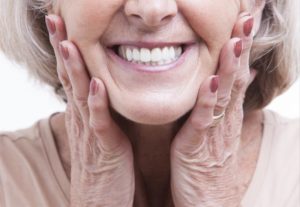
Your body goes through a lot of changes as you get older. Your hair stars turning gray, your memory becomes not as reliable as it used to be, and your hearing fades. But did you know that all sorts of changes occur in your mouth as well? Read more as a dentist in Center, TX talks about the ways your smile changes with the aging process.
1. Your Teeth Become Yellower
The outer layer of your teeth, called the enamel, is what gives your teeth their white color. As you get older, this layer gradually erodes from the daily wear and tear of chewing, exposing the layer underneath, called dentin. Dentin is closer to yellow in color, so it can make your teeth appear stained or discolored. Fortunately, this can easily be fixed with professional teeth whitening from your dentist.
2. Your Gums Might Recede
Have you ever heard someone say that a person is “long in the tooth” when describing an older person? We use this as a euphemism for looking old because your likelihood of developing gum disease increases as you age, and one symptom of gum disease is a receding gumline. More often than not, gum disease can be prevented by establishing a diligent oral hygiene routine, including daily brushing and flossing and regular six-month dental checkups.
3. You May Get Dry Mouth
As you age, you are more likely to get dry mouth, a condition where your mouth has an inadequate supply of saliva. Because saliva rinses your mouth out of leftover bits of food that attract harmful bacteria, dry mouth increases your risk of tooth decay. To combat this, sip water frequently throughout the day. You could also suck on sugarless candy or chew sugar-free gum.
4. You Might Get Sensitive Teeth
Worn-down enamel, gum disease, and tooth decay can all increase the risk of your teeth becoming sensitive to sweet, hot, cold, or acidic foods and beverages. It might even be uncomfortable if you brush your teeth too aggressively. The best way to deal with this issue is to brush and floss regularly. If the problem persists, your dentist can suggest a special toothpaste or prescribe a fluoride treatment to alleviate your discomfort.
5. Your Teeth May Shift
With increased age comes decreased jawbone density, which can result in crowded teeth, gapped, or generally crooked teeth. Your upper and lower jaws might not line up like they used to, leading to habits like teeth grinding and jaw clenching. Luckily, these problems can often be corrected with orthodontic treatment like braces or Invisalign. Minor issues like small gaps might even be able to be fixed with direct bonding, crowns, or porcelain veneers.
The main takeaway here is that you should take better care of your pearly whites as you age to prevent these problems from developing.
About the Author
Dr. Thomas Youngblood graduated with his Doctor of Dental Surgery degree in 2002 from the University of Texas Health Science Center in San Antonio. His professional memberships include the American Dental Association, Texas Dental Association, East Texas Dental Society, and an Affiliate of the American Academy of Pediatric Dentistry. His practice offers all sorts of cosmetic dentistry options to correct issues in your smile that might arise as you age. For more information, contact his Center, TX practice at (936) 427-9070.
